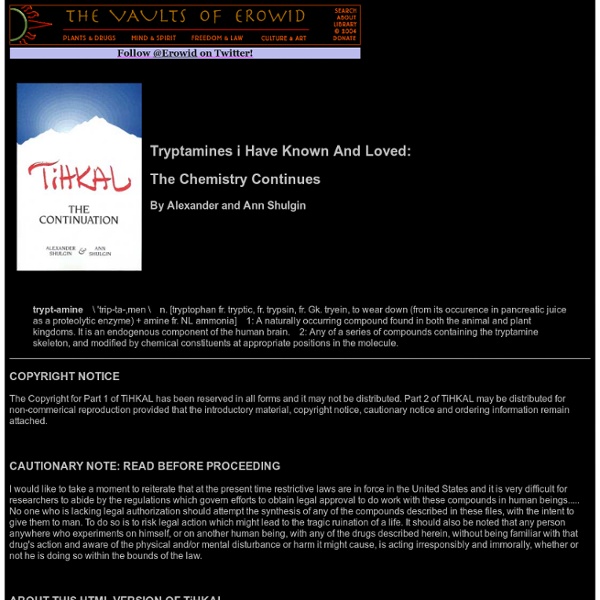



Psychoactive Vaults : Psychedelic Crisis FAQ This FAQ is not regularly updated or maintained. It may include out-of-date information. Please check the version date to see when it was most recently revised. For current information, see Erowid's summary pages in the substance's main vault. Disclaimer This FAQ is presented for informational purposes only. Credits The information contained in this FAQ has been culled from a variety of sources. Revision History 0.5 - 09/10/97 - Assembled emails and passed around for comment 1.0 - 05/03/98 - Created the basic HTML, FAQ. 1.1 - 11/07/98 - Added index, disclaimer, credits, and significantly improved organization. 1.2 - 12/18/99 - Updated Antidotes section. 2.0 - 08/22/01 - Reorganized from a realtime usage perspective, added Assessment section 2.1 - 08/01/05 - Changed reference to CPR/Rescue Breathing in "Critical or Life Threatening Situation" section 2.2 - 02/17/14 - Added Tripsit link Introduction Assessment Type of Situation Is there immediate or potential physical danger? Quick List Summary
The Heroine of Heroin – Upvoted Tracey Helton (Reddit user traceyh415) is the focus of this week’s episode. We discuss her depression growing up, how she became addicted to heroin, life as a homeless heroin addict, being the subject of the HBO documentary Black Tar Heroin, how she got clean, her involvement in harm reduction, how she got involved in Reddit’s opiates community, Naloxone, and how she saved the lives of over 120 users by sending naloxone to those with no access. Hold On "I lived in an all-female Pentecostal 'discipleship program' in rural Arkansas ... The Wave "Sailing remains one of the best things in my life. Four Walls and a Roof (Part One) "Our tent is a house. Legal intoxicant - Wikipedia Legal intoxicants, also known as legal drugs or, more commonly, as legal highs, are those intoxicating drugs which are either completely legal or not commonly prohibited by various drug laws. The most widely consumed legal intoxicant is alcohol—legal throughout the vast majority of the world's countries—but a wide array of other drugs are also not specifically banned in many international jurisdictions: these may vary from native intoxicating plants historically used by indigenous cultures to foodstuffs eaten in various parts of the world, to modern compounds and designer drugs that have not been defined as illegal, or even long-standing medicines that have intoxicating or anesthetic side effects. Where legislation imposes a general ban on psychoactive substances (as in Ireland), legal intoxicants are limited to those substances specifically exempted. Stimulants[edit] Mephedrone[edit] Mephedrone a dopaminergic, serotonergic, and adrenergic stimulant. Caffeine[edit] Nicotine[edit] Khat[edit]
Freedom Vaults : Guidelines for Saying No to Police Searches One of the main powers that law enforcement officers carry is the power to intimidate citizens into voluntarily giving up their rights. Police are trained to believe in their authority and trained to perform their interactions with private citizens with confidence. It is their job to deal with problems and they learn to manage uncomfortable situations through strength. Most people, when confronted by police get a mild panic reaction, become anxious, and try to do whatever they can to minimize the time spent with the officer. A common situation is that of the traffic stop. The Federal Supreme Court has ruled that as long as the police do not force an individual to do something, the individual is acting voluntarily, even if a normal person would feel very intimidated and would not reasonably feel they could say no. Unfortunately police will often try to push citizens to accept a search, to the point of ignoring when you say "no". The Terry v. In a recent decision (Wyoming v. Stay Calm.
Erowid Choose Your Own Drug-Fueled Misadventure: Flight of Terror You awaken on a plane. You are seated comfortably in that one odd, solitary chair nearest the fire exits, so you have plenty of leg room and minimal witnesses – y'know, just in case the mood strikes you. “Are you aware of the safety procedures?” The flight attendant had asked you when you first boarded. “What do I look like, some kind of gaping asshole?” Ron, your flight attendant, has spent the duration of the flight crying in the bathroom. You are surrounded by tiny, empty liquor bottles, which you enjoy, because it makes you feel like Andre the Giant. “You hear about those full-body scanners, man?” “I love that movie,” you answer, excited to finally find somebody who understands you, "when that guy’s head is like ‘PKSHOW’ and you’re all ‘fuck yes!!!’ Fuckin' everything explodes in that movie: Cars, heads, kid's asses... “No, man. “Sweet,” you reply, reclining happily, “I’ll be sure to chub up next time I see one. “Ha! Your guts freeze. “If you’re holding, man. “I can’t!” Page 2 “CHO!”
Drugs Forum - Inbox Forum Rules Registration to this forum is free! We do insist that you abide by the rules and policies detailed below. If you agree to the terms, please check the 'I agree' checkbox and press the 'Register' button below. Please post questions in the Forum use forum. Illegal Activity Requesting or offering illegal substances is not allowed. This includes chemicals on the UN red list, DEA List I or scheduled precursors as well as threshold or above quantities of DEA List II chemicals. This will get you banned instantly. If your request for a substance results in a reaction, the person reacting might be pulling your chain or an organization that will bust you. This forum software contains a script which alerts the admin of specific events. Requesting, offering or trading sources for illegal substances is not allowed. This will get you banned instantly. Do not PM members or moderators with illegal propositions or questions. This will get you banned instantly. Commercial Products Accounts Posting Rules
shrooms